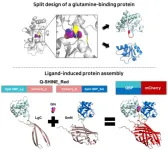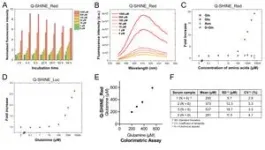(Press-News.org) In 2023, life expectancy in Korea will be 83.6 years, the third highest among OECD countries, and it is steadily increasing every year. As the proportion of the elderly population increases, the social cost of treating various geriatric diseases is also increasing rapidly, and there is a growing interest in early diagnosis of diseases. Among the various diagnostic methods, researchers are actively conducting research on measuring glutamine as an indicator of geriatric diseases by finding that the concentration of glutamine in the cells and blood of patients with serious diseases such as cancer, diabetes, and dementia is significantly changed compared to normal people.
Dr. Seo, Moon-Hyeong of the Natural Product Research Center at the Korea Institute of Science and Technology (KIST), together with Dr. Park, Keunwan of the Natural Product Informatics Research Center, have developed a technology that can quickly and accurately measure glutamine concentrations without complicated measurement processes and expensive analytical equipment through the principle of 'ligand-induced protein assembly'.
Glutamine is an amino acid in the blood that is used by cells to synthesize proteins or as an energy source, and its rapid fluctuation in certain situations makes it a useful biomarker for the treatment and early diagnosis of disease. For this reason, researchers are actively studying glutamine metabolism in the body to diagnose metabolic and degenerative diseases, including cancer treatment by inhibiting the metabolism of glutamine, which is also a nutrient for cancer cells.
Until now, the measurement of glutamine concentration in the body has relied on expensive specialized analytical equipment such as amino acid analyzers, which cannot measure changes in glutamine concentration in living cells in real time. In the case of relatively low-cost research kits, cumbersome pre-treatment processes such as protein removal in biological samples were required, resulting in long measurement times and low accuracy.
The team developed a sensor protein for measuring glutamine based on the principle of "ligand-induced protein assembly" that can easily measure the concentration of glutamine in the blood. By separating a glutamine binding protein into two artificial proteins and then binding to the sample, and named it Q-SHINE by combining Q, the symbol for glutamine, and SHINE, which means brightly glowing. Experiments showed that the Q-SHINE sensor was highly selective, not responding to amino acids with similar structure such as glutamic acid and D-glutamine. The lowest concentration of glutamine that can be measured is 1 micromolar (µM, one millionth of a molar), which is 20 times lower than the enzymatic assay most commonly used in research kits. In addition, the sensor protein can be easily produced in E. coli, making it possible for a research kit to analyze glutamine concentrations at the same level as analytical instruments worth hundreds of millions of dollars.
The team also used the Q-SHINE sensor to monitor changes in glutamine concentration in the cytoplasm and mitochondria of living cells in real time. In particular, by verifying the difference in glutamine concentration between cancer cells and normal cells, it is expected to speed up the development of anticancer drugs by inhibiting glutamine metabolism.
"The Q-SHINE sensor developed by KIST will enable easy monitoring of glutamine concentration, similar to the self-monitoring of blood glucose by diabetics," said Dr. Seo, Moon-Hyeong. "If used for glutamine metabolism research, it will greatly contribute to early diagnosis and identification of causes of severe geriatric diseases such as cancer, diabetes, and dementia, as well as development of cancer drugs that regulate glutamine metabolism."
###
KIST was established in 1966 as the first government-funded research institute in Korea. KIST now strives to solve national and social challenges and secure growth engines through leading and innovative research. For more information, please visit KIST’s website at https://eng.kist.re.kr/
The research, which was supported by the Ministry of Science and ICT (Minister Lee Jong-ho) through the KIST Major Project and the Korea Research Foundation's Excellent New Research Project, was published in the latest issue of the international journal Sensors and Actuators, B: Chemical (IF=8.4, top 0.8% in JCR).
END
Make diagnosing serious geriatric diseases as easy as measuring blood sugar
Developed a new biosensor for measuring glutamine with greater convenience and accuracy than before. Successfully monitored real-time changes in the concentration of glutamine in living cells.
2023-10-11
ELSE PRESS RELEASES FROM THIS DATE:
Commonly used herbicide is harmful to adolescent brain function
2023-10-11
Herbicides are the most used class of pesticides worldwide, with uses in agriculture, homes and industry. Exposures to two of the most popular herbicides were associated with worse brain function among adolescents, according to a study led by researchers at the Herbert Wertheim School of Public Health and Human Longevity Science at University of California San Diego.
In the Oct. 11, 2023 online issue of Environmental Health Perspectives, the researchers reported measuring metabolite concentrations of two commonly used herbicides — glyphosate and 2,4-dichlorophenoxyacetic acid (2,4-D) — and the insect repellent DEET in urine samples ...
New antibiotic drug developed by HKU Chemistry research team approved for clinical trials in humans
2023-10-11
A new antibiotic drug developed by a research team led by Professor Li Xuechen from the Department of Chemistry at The University of Hong Kong (HKU) has recently gained approval from the authorities to undergo clinical trials in the Mainland.
The new drug, which has taken the research team ten years to develop and is named Kynomycin, received the "Notice of Approval for Drug Clinical Trials" from the National Medical Products Administration of China to be tested in human subjects.
The new antibiotic drug targets complex skin and soft tissue infections (cSSTI) caused by bacteria. It ...
Scientists discover ‘flipping’ layers in heterostructures to cause changes in their properties
2023-10-11
Transition metal dichalcogenide (TMD) semiconductors are special materials that have long fascinated researchers with their unique properties. For one, they are flat, one-atom-thick two-dimensional (2D) materials similar to that of graphene. They are compounds that contain different combinations of the transition metal group (e.g., molybdenum, tungsten) and chalcogen elements (e.g., sulfur, selenium, tellurium).
What's even more fascinating is that assembling different TMD layers into vertical stacks creates a new artificial material called a van der Waals (vdW) heterostructure. By incorporating different materials, it becomes possible to ...
USC researchers develop blood test for early-stage ovarian cancer
2023-10-11
High-grade serous ovarian carcinoma (HGSOC) is the most common type of ovarian cancer. It is also the most lethal form, in part because clinicians do not have effective ways to screen women for it during the cancer's early stages, when it's easiest to treat.
For patients with a pelvic mass (an abnormal lump or growth in the lower abdomen), it is difficult to detect whether the growth is benign or cancerous ahead of surgery. Unlike many other cancers, biopsies are typically not an option. That makes it hard for doctors to choose the best course of treatment.
Now, a new blood test ...
Killing remains a threat to Bornean orangutans
2023-10-11
University of Queensland research has found despite considerable conservation efforts, the illegal killing of critically endangered orangutans on Borneo may be an ongoing threat to the species.
PhD candidate Emily Massingham from UQ’s Faculty of Science managed a team of researchers which visited 79 villages across the Bornean orangutan range in Kalimantan, conducting face to face interviews with 431 people.
“Our study builds on previous research which indicated killing was one of the key reasons for orangutan population decline, alongside habitat loss,” Ms Massingham said.
“The ...
Lundquist Investigator Dr. Loren Miller is the lead author of the “universal decolonization” study published in the New English Journal of Medicine
2023-10-11
Nursing homes that use a chlorhexidine bathing routine to clean the skin, and an over-the-counter antiseptic to clean the nose, prevent serious infections and reduce the amount of antibiotic-resistant organisms in the nursing home setting, according to the findings of researchers at Harbor-UCLA Medical Center, the University of California, Irvine, and the Centers for Disease Control and Prevention (CDC). The findings were published today in the New England Journal of Medicine.
“The ...
Renting rather than owning a private sector home linked to faster ‘biological ageing’
2023-10-11
The biological impact of renting, as opposed to owner occupancy, is nearly double that of being out of work vs having paid employment, the findings suggest.
Fortunately, these effects are reversible, emphasising the importance of housing policy in health improvement, say the researchers.
Numerous aspects of housing are associated with physical and mental health, including cold, mould, crowding, injury hazards, stress, and stigma. But exactly how they might exert their effects isn’t entirely clear, say the researchers.
To explore this further, they drew on epigenetic ...
Genes may be responsible for third of complex regional pain syndrome cases
2023-10-11
But the condition is less common in men, even though they are more likely to have the 4 genetic variations implicated in heightened risk, suggesting that there may be sex specific causes, say the researchers.
Most cases of CRPS are usually triggered by an injury, with the skin of the affected body part hypersensitive to the slightest touch or temperature change. CRPS is difficult to treat, and while it often improves with time, some people experience intense pain for many years.
But why some people develop CRPS yet others don’t after the same injury, isn’t clear. ...
Singapore’s smoke-free law may have warded off 20,000 heart attacks in over 65s
2023-10-11
The extension was associated with a monthly fall in the rate of heart attacks, with older people and men benefitting the most from the move.
Second-hand smoke exposure is responsible for 1.3 million annual deaths around the globe, many of which are caused by heart attacks, note the researchers.
But the existing evidence on the health benefits of comprehensive smoke-free laws, which many countries (67 since 2003) have implemented, is largely confined to indoor smoking bans rather than those for housing estates and outdoor spaces, they say.
In 2013 Singapore extended smoke-free legislation ...
Death is only the beginning: Birds disperse eaten insects’ eggs
2023-10-11
Relationship patterns among flightless stick insects suggest that birds disperse the eggs after eating gravid females. Lab experiments previously suggested the possibility, but a new genetic analysis of natural populations in Japan by Kobe University researchers now supports the idea.
Most species of stick insects are flightless, yet they are distributed over wide distances and across geographical features that would impede the expansion of flightless animals. This has caused researchers to speculate that their eggs might be dispersed by birds feeding on gravid females, much in the same way as many plant species rely on birds eating their seeds together ...
LAST 30 PRESS RELEASES:
University of Cincinnati experts present research at annual hematology event
ASH 2025: Antibody therapy eradicates traces of multiple myeloma in preliminary trial
ASH 2025: AI uncovers how DNA architecture failures trigger blood cancer
ASH 2025: New study shows that patients can safely receive stem cell transplants from mismatched, unrelated donors
Protective regimen allows successful stem cell transplant even without close genetic match between donor and recipient
Continuous and fixed-duration treatments result in similar outcomes for CLL
Measurable residual disease shows strong potential as an early indicator of survival in patients with acute myeloid leukemia
Chemotherapy and radiation are comparable as pre-transplant conditioning for patients with b-acute lymphoblastic leukemia who have no measurable residual disease
Roughly one-third of families with children being treated for leukemia struggle to pay living expenses
Quality improvement project results in increased screening and treatment for iron deficiency in pregnancy
IV iron improves survival, increases hemoglobin in hospitalized patients with iron-deficiency anemia and an acute infection
Black patients with acute myeloid leukemia are younger at diagnosis and experience poorer survival outcomes than White patients
Emergency departments fall short on delivering timely treatment for sickle cell pain
Study shows no clear evidence of harm from hydroxyurea use during pregnancy
Long-term outlook is positive for most after hematopoietic cell transplant for sickle cell disease
Study offers real-world data on commercial implementation of gene therapies for sickle cell disease and beta thalassemia
Early results suggest exa-cel gene therapy works well in children
NTIDE: Disability employment holds steady after data hiatus
Social lives of viruses affect antiviral resistance
Dose of psilocybin, dash of rabies point to treatment for depression
Helping health care providers navigate social, political, and legal barriers to patient care
Barrow Neurological Institute, University of Calgary study urges “major change” to migraine treatment in Emergency Departments
Using smartphones to improve disaster search and rescue
Robust new photocatalyst paves the way for cleaner hydrogen peroxide production and greener chemical manufacturing
Ultrafast material captures toxic PFAS at record speed and capacity
Plant phenolic acids supercharge old antibiotics against multidrug resistant E. coli
UNC-Chapel Hill study shows AI can dramatically speed up digitizing natural history collections
OYE Therapeutics closes $5M convertible note round, advancing toward clinical development
Membrane ‘neighborhood’ helps transporter protein regulate cell signaling
Naval aviator turned NPS doctoral student earns national recognition for applied quantum research
[Press-News.org] Make diagnosing serious geriatric diseases as easy as measuring blood sugarDeveloped a new biosensor for measuring glutamine with greater convenience and accuracy than before. Successfully monitored real-time changes in the concentration of glutamine in living cells.







